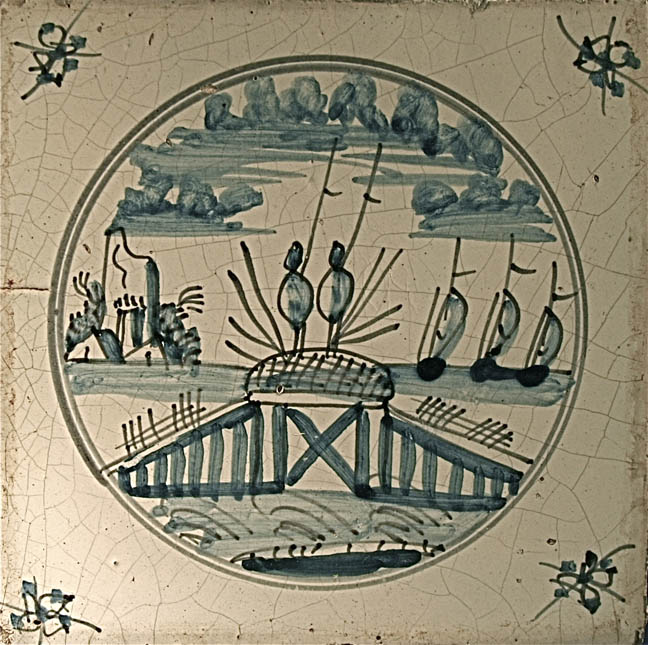

Title: Antique Stylized Ship Hand Painted Blue Glazed Tile Design
Shipping: $18.00
Artist: N/A
Period: 18th Century
History: N/A
Origin: N/A
Condition: Excellent
Item Date: 1650 to 1700
Item ID: 4834
This is a lovely old hand painted tile with design ships, it has a beautiful white glaze. In very good condition. The tile is 6" square. We think it dates from around the 1650s or 1700s. Wonderful Antique Art Tile! These were designed to last a lifetime and to retain their vibrant colors indefinitely! High-gloss glazes applied over a moulded base tile, slightly irregular outside edges. This was widely dis-tributed across the globe, finding their way to a host of different countries including the United States.
Link: http://en.wikipedia.org/wiki/Tile
A tile is a manufactured piece of hard-wearing material such as ceramic, stone, metal, or even glass. Tiles are generally used for covering roofs, floors, walls, showers, or other objects such as tabletops. Alternatively, tile can sometimes refer to similar units made from lightweight materials such as perlite, wood, and mineral wool, typically used for wall and ceiling applications. Tiles are often used to form wall and floor coverings, and can range from simple square tiles to complex mosaics. Tiles are most often made from porcelain, fired clay or ceramic with a hard glaze, but other materials are also commonly used, such as glass, metal, cork, and stone. Tiling stone is typically marble, onyx, granite or slate. Thinner tiles can be used on walls than on floors, which require thicker, more durable surfaces. Decorative tilework should be distinguished from mosaic, where forms are made of great numbers of tiny irregularly positioned tesserae in a single colour, usually of glass or sometimes ceramic. The earliest evidence of glazed brick is the discovery of glazed bricks in the Elamite Temple at Chogha Zanbil, dated to the 13th century BCE. Glazed and coloured bricks were used to make low reliefs in Ancient Mesopotamia, most famously the Ishtar Gate of Babylon (ca. 575 BCE), now partly reconstructed in Berlin, with sections elsewhere. Mesopotamian craftsmen were imported for the palaces of the Persian Empire such as Persepolis. Tiling was widespread in the time of the Sinhalese kings of ancient Sri Lanka, using smoothed and polished stone laid on floors and in swimming pools. Historians consider the techniques and tools for tiling as well advanced, evidenced by the fine workmanship and close fit of the tiles.Tiling from this period can be seen Ruwanwelisaya and Kuttam Pokuna in the city of Anuradhapura. Islamic tiles: Phoenix on the portal of Nadir Divan-Beghi Madrasah, Bukhara, Uzbekistan Early Islamic mosaics in Persia consist mainly of geometric decorations in mosques and mausoleums, made of glazed brick. Typical turquoise tiling becomes popular in 10th-11th century and is used mostly for Kufic inscriptions on mosque walls. Seyed Mosque in Isfahan (1122 AD), Dome of Maraqeh (1147 AD) and the Jame Mosque of Gonabad (1212 AD) are among the finest examples. The dome of Jame' Atiq Mosque of Qazvin is also dated to this period. The golden age of Persian tilework begins with under the Timurid Empire. Single color tiles were cut into small pieces and assembled by pouring liquid plaster between them. After hardening, these panels were assembled on the walls of buildings. But the mosaic was not limited to flat areas. Jame Mosque in Yazd (1324-1365 AD) and Goharshad Mosque (1418 AD) are prominent examples of brick and tile mosaics of interiors and external surfaces of domes. Islamic buildings in Bukhara (16th-17th century) also exhibit very sophisticated floral ornaments. Mihrabs, being focus points of mosques, were usually the places where most sophisticated tilework was placed. The 14th century mihrab at Madrasa Imami in Isfahan is an outstanding example of aesthetic union between the islamic calligrapher's art and abstract ornament. The pointed arch, framing the mihrab's niche, bears an inscription in Kufic script used in 9th-century Qur'an. One of the best known architectural masterpieces of Iran is the Shah Mosque in Isfahan, from the 17th century. Its dome is a prime example of tile mosaic and it's winter praying hall houses one of the finest ensembles of cuerda seca tiles in the world. Wide variety of tiles had to be manufactured in order to cover complex forms of the hall with consistent mosaic patterns. The result was a technological triumph as well as a dazzling display of abstract ornament. During the Safavid period mosaic ornaments vere often replaced by a haft rang (seven colors) technique. Pictures were painted on plain rectangle tiles, glazed and fired afterwards. Besides economic reasons, the seven colors method gave more freedom to artists and was less time-consuming. It was popular until Qajar period when the palette of colors was extended by yellow and orange. The Persianate tradition continued and spread to much of the Islamic world, notably the Ä°znik pottery of Turkey under the Ottoman Empire in the 16th and 17th centuries. Palaces, public buildings, mosques and turbe mausoleums were heavily decorated with large brightly coloured patterns, typically with floral motifs, and friezes of astonishing complexity, including floral motifs and calligraphy as well as geometric patterns.